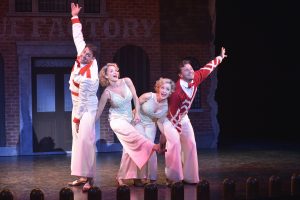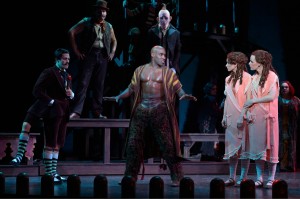Side Show a Moving, Poignant Romance in La Jolla
Toward the end of Side Show, the haunting musical now at the La Jolla Playhouse, Emily Padgett does a simple, graceful pirouette, a basic dance twirl that can read as joy, freedom, determination… something along those lines.
Here, in a dream sequence, it is a final, crushing delivery of raw poignancy. Because Daisy Hilton, the character played by Miss Padgett, will never do a pirouette. She is permanently joined at her left hip, by flesh and bone, to the right hip of her twin sister Violet.

Barrett Martin, Emily Padgett, Erin Davie and Matthew Hydzik, left to right, in La Jolla Playhouse Side Show. Kevin Berne Photo
The musical, by Bill Russell and Henry Krieger, is based on the lives and joint career of the real Hilton sisters (1908-1969) who spent most of their lives on display, in pubs, pit shows, wax museums and freak shows around their native England and, later, in concert halls and theatres around Europe and Australia. In America, they were popular in vaudeville, less so in movies and ultimately, forgotten in a Southern backwater where they worked as grocery clerks until their death from the Hong Kong flu.
The Russell-Krieger musical was a Broadway flop in 1997 but it endured as an off-beat revival item which attracted the attention of Hollywood director Bill Condon, who had turned an earlier Broadway show – Dreamgirls – into a successful film. Fortunately for the Playhouse and its audiences, the three decided on a stage redo, with Condon directing and supplying some new book material, instead of a film.
Despite its deep show business roots, the subject seems an odd choice for a romantic musical. With the most compassionate will in the world it’s still hard to subdue the smutty innuendos. In life, both twins had failed marriages and Daisy gave birth to a son. So how, goes the irresistible question, did that work? There’s even a crudely saucy vaudeville number – “1+1=3” – that invites speculation.
Wherever each auditor’s curiosity falls on the spectrum from compassionate to creepy, the authors don’t even try to dodge the snickers but instead use the tensions as flavoring. This is reality for the people in this story so, what’s next?
It’s a miserable life at best, haunted by compromises that cannot be avoided. Despite a childhood of cruelty and exploitation that would make Dickens wince, Violet and Daisy turn into sweet girls headlining a carnival sideshow with fellow “curiosities” in less permanent roles – tattooed lady, reptile man, the geek who bites off chicken heads, the king of the cannibals – all of whom have hearts of gold. Except the boss, of course, played with smarmy glee by Robert Joy as a classic exploitive monster.
Arriving to take the girls away from all this is a square-shooting promoter, blackballed from Broadway for undisclosed indiscretions, and his dreamy choreographer sidekick. After a confrontation (and a couple of songs) the girls leave behind their sorrowful colleagues and the Only Home They’ve Ever Known to seek their fortunes.
It is, in short, a polished plot from the fairy tale locker with the usual assortment of stereotypical characters just waiting for the specifics of this latest version. Except for one problem: that fleshly link that gives them their act in exchange for their fates.
Medical remedies have been developed more recently but there apparently wasn’t much chance of successfully dividing the girls back in the day, an option explored in a number called “Cut Them Apart,” where a squad of bewhiskered sawbones right out of a Marx Brothers movie menace them in shadow play.
And, of course, there’s the (mostly) unacknowledged reality that, separated, they’d just be two more pretty girl of modest talent. So they are forced to face the reality that their status is permanent and their relationships with other are, for a variety of reasons, doomed to fall away, incomplete. Even when their big break comes along, it’s featured roles in Tod Browning’s notorious 1932 horror film Freaks, banned in the USA for 30 years.
The journey is melancholy but stuffed with philosophical potential, if the sheer mechanics of the situation can be got past. So that’s the job of this company.
In addition to dealing with the queasy subject matter, Condon also faced some unusual staging problems. His two leading actors must always be together, same side to, facing the same direction. There are no ways to keep secrets, to hide anything, to work out individual moments. Not insurmountable but certainly restrictive. By far the best solutions are found in the show’s most rousing and successful musical number, a triumphant vaudeville spectacular titled “Brother! Brother” that features the girls, their two dance partners and a couple of other boys. Congratulations and top marks to choreographer Anthony van Laast.

David St. Louis, center, with Emily Padgett and Erin Davie (right) in La Jolla Playhouse Side Show. Kevin Berne Photo
In fact, congratulations all around. Krieger’s music is solidly serviceable, though clunkier in execution that the many musical hands listed might forecast. Russell’s words avoid the traps of leering and sarcasm, sticking mostly to straightforward sub-melodramatic exchanges. (Not always. “I’m well-connected,” says the promoter. “So are we,” says one of the twins.)
Paul Tazewell’s costumes, relying heavily on some prostheses and makeup for the side show acts, are terrific and even moving. David Rockwell’s scenery gives plenty of room for scampering about in a backstage fantasy.
Miss Padgett and Erin Davie, as Violet, the other sister, are pleasantly matched and patiently content in their enforced stasis. Mathew Hydzik is graceful and touchy as Violet’s partner and Manoel Felciano is convincing as the promoter who sees beyond the grotesquerie to the beauty of the sisters.
There are plenty other good performances, both ensemble and individual, but it’s impossible not to single out David St. Louis, impressive as that cannibal king but far more so as a stern, straight-shooting admirer and protector. He leads the whole acting company in spreading a solemn dignity that much enhances and deepens the project.
[box] Continues in the Mandell Weiss Theatre at 7:30 p.m. Tuesdays and Wednesdays, 8 :30 p.m. Thursdays-Saturdays, 2 p.m. Saturdays and Sundays and 7 p.m. Sundays through Dec. 15, 2013.[/box]

Welton Jones has been following entertainment and the arts around for years, writing about them. Thirty-five of those years were spent at the UNION-TRIBUNE, the last decade was with SANDIEGO.COM.


